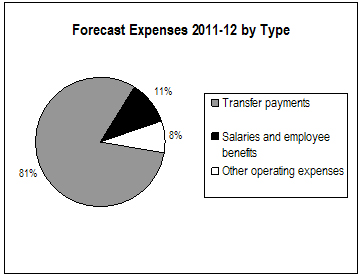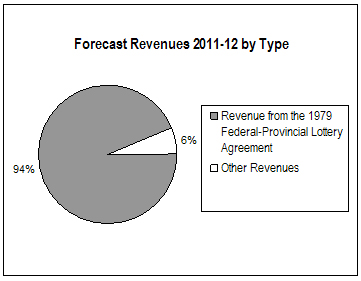Common menu bar links
Breadcrumb Trail
ARCHIVED - Canadian Heritage - Report
 This page has been archived.
This page has been archived.
Archived Content
Information identified as archived on the Web is for reference, research or recordkeeping purposes. It has not been altered or updated after the date of archiving. Web pages that are archived on the Web are not subject to the Government of Canada Web Standards. As per the Communications Policy of the Government of Canada, you can request alternate formats on the "Contact Us" page.
Section III – Supplementary Information
Financial Highlights
The financial highlights presented within this Report on Plans and Priorities are intended to serve as a general overview of Canadian Heritage forecasted operations. The future-oriented statement of operations is prepared in accordance with accrual accounting principles.
| Condensed Future-oriented Statement of Operations For the Year (Ended March 31) |
Estimated Results 2010-11 |
Forecasts 2011-12 |
|---|---|---|
| Expenses | ||
Transfer Payments Operating Expenses Total Expenses |
1,051,265 291,924 1,343,189 |
969,112 |
| Revenues | ||
| Total Revenues | 70,932 | 71,824 |
| Net Cost of Operations | 1,272,257 | 1,129,953 |
The variance between the figures above and the planned spending amounts provided in other sections of the RPP is mainly explained by such items as non-respendable revenues, services provided without charge by other government departments, amortization, and severance and vacation pay liability adjustments. For more information, refer to note 5 in the Future-oriented Statement of Operations.

[Graphic: Forecasted Expenses 2011-12 by Type]
Total forecasted expenses for 2011-12 are $1.202 million. Major forecasted expense areas include transfer payments of $969.1 million (81 percent) and salaries and employee benefits of $136.1 million (11 percent).

[Graphic: Forecasted Revenues 2011-12 by Type]
Total forecasted revenues for 2011-12 are $71.8 million. The revenue from the 1979 Federal-Provincial Lottery Agreement, totalling $65 million, accounts for 94 percent of the forecasted revenues. As stipulated in the agreement, the amount received annually is adjusted to reflect inflation.
Future-oriented Statement
The Future-oriented Statement of Operations of the Department of Canadian Heritage for the years ending March 31, 2011 and March 31, 2012 is available on the Departmental Website.
Supplementary Information Tables
All electronic supplementary information tables found in the 2011-12 Report on Plans and Priorities can be found on the Treasury Board of Canada Secretariat’s Web site at: http://www.tbs-sct.gc.ca/rpp/st-ts-eng.asp .
- Details on Transfer Payment Programs
- Up-Front Multi-Year Funding
- Green Government Operations
- Horizontal Initiatives
- Upcoming Internal Audits and Evaluations over the next three fiscal years
- Sources of Respendable and Non-Respendable Revenue
- User Fees
Section IV - Other Items of Interest
Sustainable Development
Based on the Federal Sustainable Development Strategy (FSDS), the Department of Canadian Heritage commits to:
- Providing more specific information on departmental sustainable development activities appropriate to the department’s mandate;
- Strengthening the application of Strategic Environmental Assessments (SEAs) by ensuring that the Government’s environmental goals are taken into account when pursuing social and economic goals;
- Pursuing best practices on reporting on summary information on the results of SEAs linked to the FSDS goals and targets, in order to ensure that environmental decision making is more transparent.
Other Items of Interest
- Legislation related to Canadian Heritage
- Portfolio Crown corporations and other organizations
- Regional offices
1 “Economic Contribution of the Culture Sector to Canada’s Provinces,” Culture, Tourism and the Centre for Education Statistics Research Papers, Statistics Canada, 2007.
2 Includes revenues from recordings, concerts, commercial radio advertising revenues, and performing rights payments, International Federation of the Phonographic Industry, 2008.
3 2008 Canadian Interactive Industry Profile, Canadian Interactive Alliance.
